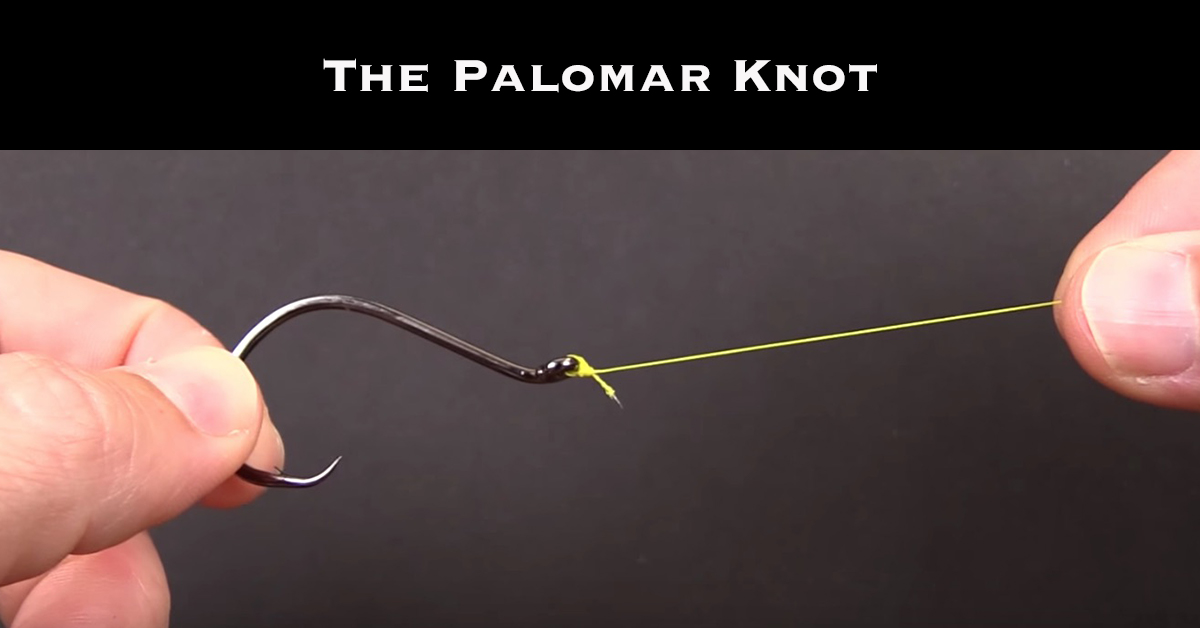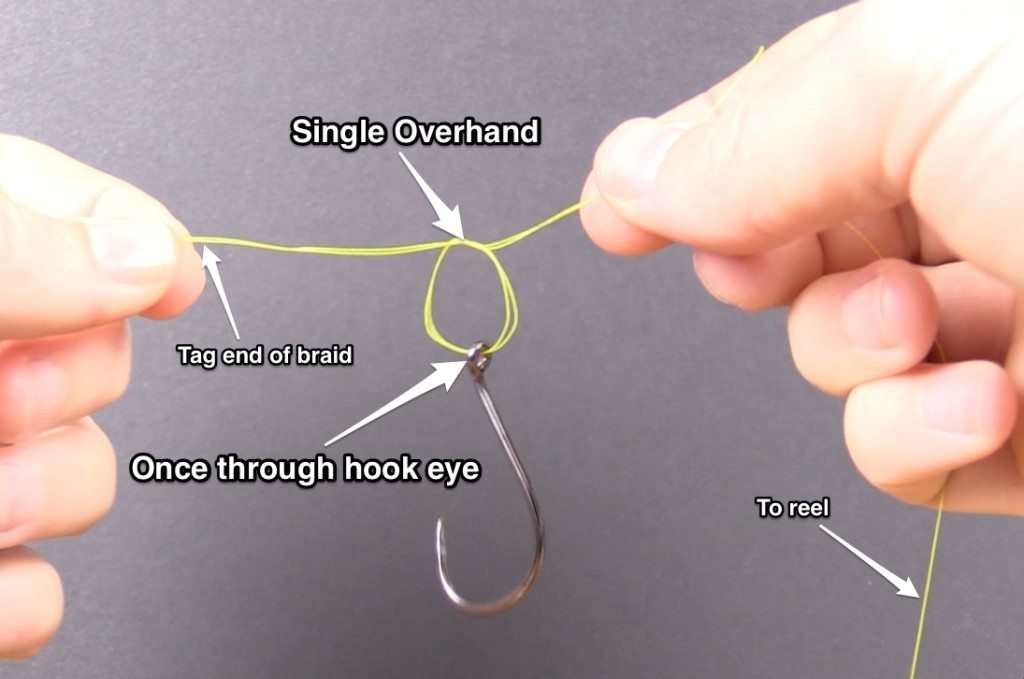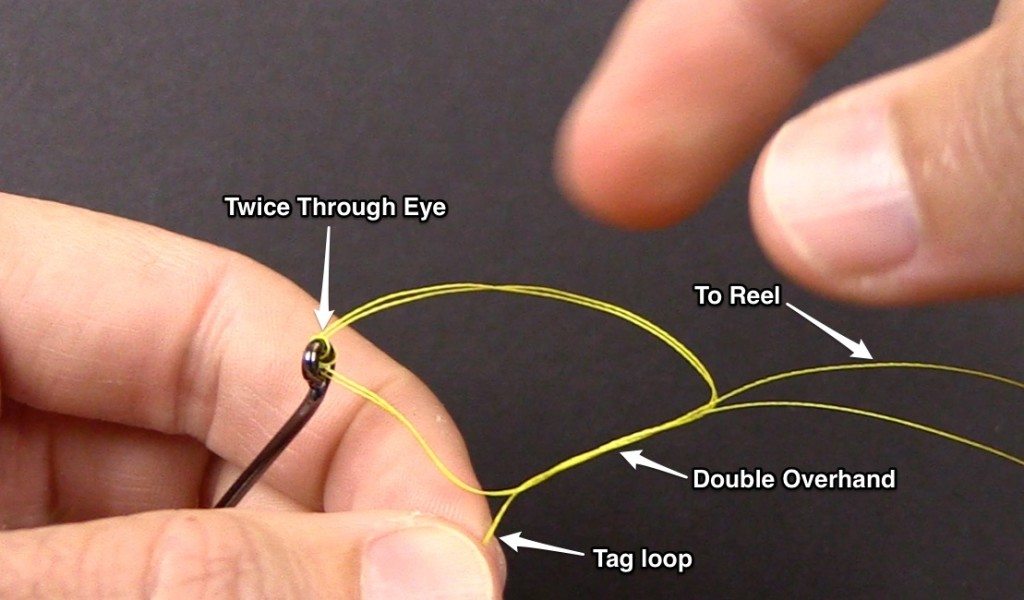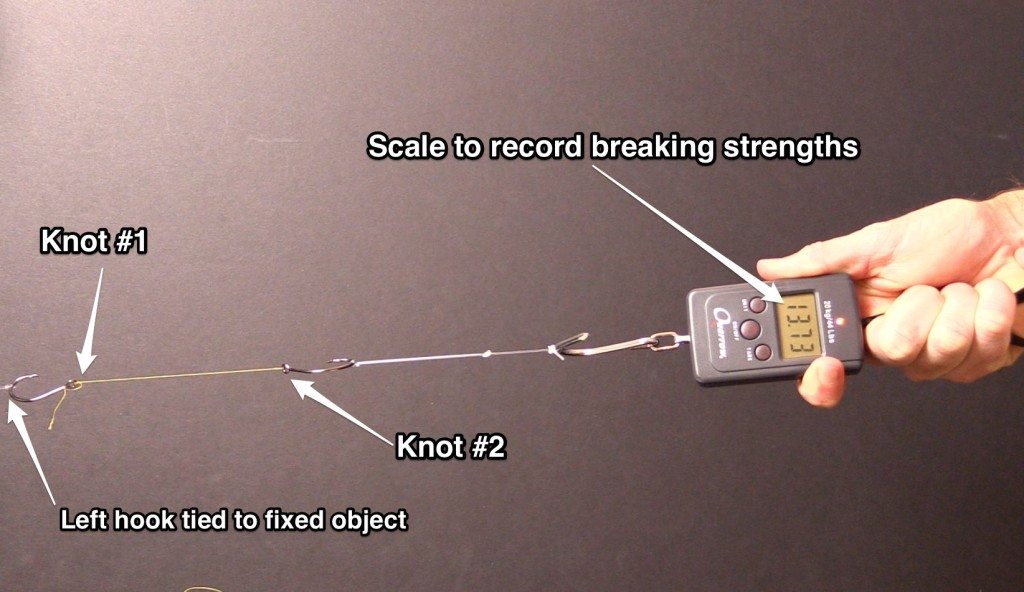Palomar Knot: How To Tie The Palomar Knot [Fluoro & Braid Adjustments]
- By: Luke Simonds
- on
- Found In: Fishing Knots, Fishing Tips, Knot Contest, Terminal Knot (Snug)

Palomar Knot Strength Analysis
The Palomar Knot is one of the most popular fishing knots in the world.
And this post will show you the best ways to tie this very popular “Palomar Knot” based on the line type that you are using… braid vs. mono/fluoro.
Yes, even great knots like the Palomar need to be adjusted based on the line that is used.
Specifically, we’ll focus on monofilament (including Fluorocarbon) and braid because they are the most popular and have such different characteristics.
First, here’s the general 5 steps required for any Palomar knot:
5 Steps To Tie The Palomar Knot
Here are the 5 steps correctly tying a Palomar Knot.
- Double over the tag end of the line
- Staring with 5 to 6 inches of doubled line is easiest
- Thread the end of the doubled line through the eye of the hook/lure
- Pinching the end of the loop to form a point makes this step much easier
- Make an overhand knot on the doubled line leaving the hook/lure in the middle
- Make sure that the doubled line tag end forms a loop that is at least as wide as the hook/lure
- Thread the hook/lure through the doubled tag line
- This is simple for hooks, but it can be difficult with larger lures
- Tighten the lines down until it forms the final Palomar Knot
- Wet line with saliva or water before tightening
See below for the results and to see detailed videos showing the best way to tie a Palomar Knot for both monofilament and braid fishing lines.
Strongest Palomar Knot Analysis
For this knot analysis, I tied two different variations of the Palomar knot on a single strand of line 5 times. Then, I soaked the knots in water for ~15 minutes to resemble their state when in use.
Next, I pulled on each line with a steadily increasing tension until the weaker one broke and recorded the breaking tension using a small scale that is connected to the line.
Once the breaking points of the 5 lines were all recorded, I tied 5 more using different tying styles and repeated the steps.
Strongest Palomar Knot On Mono
Monofilament line (of course including the popular fluorocarbon type of mono) has much more friction than braid, so often requires much less turns and twists compared to braid in order to be the strongest…
And even though it seems as if more twists/turns would result in a stronger knot, that theory has been proven false many times in our earlier testing.
Note: All tests with mono were performed with 30 lb Berkley Trilene tied to a circle hook
Palomar Knot On Mono Test #1
First, I tied a slight variation of the Palomar that simply has a double overhand knot (vs. the single overhand knot) before feeding the hook through the loop. This style is referred to as a “Double Palomar” in some YouTube videos.
- Original Palomar won 4 of the 5 tests… it’s loss was at 22 lbs
- The Double Palomar knot won once… it’s 4 losses were in the 27 lb to 32 lb range
Conclusion: The original Palomar is better since it won a majority of the contests while also being quicker to tie (one less step)
Palomar Knot On Mono Test #2
This next version of the Palomar involves feeding the doubled tag end of the line through the hook eye twice and then doing a single overhand knot before feeding the hook through the loop. And I tested this against the original Palomar since it won the first test.
- Original Palomar won 3 of the 5 tests… it’s losses were at 28 lbs and 29 lbs
- The Double Palomar knot won 2 out of 5… it’s 3 losses were in the 29 lb to 31 lb range
Conclusion: The original Palomar is better since it won a majority of the contests while also being quicker to tie (one less step).
Palomar Knot On Mono Test #3
Since the original Palomar won again, I decided to see what would happen if a tied the same style that won the braid contest (2 turns through eye and then double overhand). However, the friction of the added twists were so high that it became very difficult to cinch the knot without damaging the lines. So I ended to contest there and concluded that the original style is best for mono.
How To Tie The Palomar Knot For Mono
After the testing above, the long time original Palomar knot proved to hold its own against the variations. It proved to be the stronger option while also being easier to tie.
Note: Although this knot won the contest in terms of strength, I still recommend using loop knots when fishing with artificial lures because they allow for more action which will lead to more strikes… click here to see our loop knot contest.
Strongest Palomar Knot On Braid
After including the Palomar knot in an earlier contest for tying braid to a swivel/hook, I knew that the standard Palomar knot was not going to be the best overall choice… click here to see that contest.
However, I was very curious to find out if there was some sort of an improved Palomar knot for braid, so decided to try out some variations of the Palomar and put them up against the original.
Note: All tests with braid were performed with 10 lb PowerPro tied to a circle hook
Palomar Knot On Braid – Test #1
First, I tied a slight variation of the Palomar that simply has a double overhand knot (vs. the single overhand knot) before feeding the hook through the loop… this style is referred to as a “Double Palomar” in some YouTube videos.
- Standard Palomar won 3 of the 5 tests… it’s losses were in the 14 lb to 15 lb range
- The Double Palomar knot won twice… it’s 3 losses were in the 12 lb to 17 lb range
Conclusion: The standard Palomar is better than the double Palomar since it won a majority of the contests while also being quicker to tie (one less step).

Palomar Knot On Braid – Test #2
This next version of the Palomar involves feeding the original doubled over tag end through the eye of the hook two times (vs. one in the standard style).
And then also tying the double overhand knot as done in the first test. I tested this against the original Palomar since it won the first test.
- This Improved Double Palomar knot won all five tests… the original version broke in the 13 lb to 17 lb range in all 5 tests.
Conclusion: This Improved Double Palomar consisting of two turns through the hook eye followed by a double overhand knot makes for a stronger knot.

Palomar Knot On Braid – Test #3
Since the original Palomar lost, I decided to see what would happen if a triple overhand knot was used, so I tied it 5 times and put it up against the winner of test #2.
- This new 2 x 3 Palomar won once… its 4 losses were in the 15 lb to 18 lb range
- The winner of test #2 won 4 of the 5 trials… its loss was at 17 lbs
Conclusion: Although this newer 2 x 3 Palomar included an extra twist, its inclusion actually hurt the overall strength of the knot relative to the 2 x 2 version.
How To Tie The Strongest Palomar Knot For Braid
After the tests above, I believe that the best way to tie the Palomar knot is to feed the doubled tag end through the hook eye twice, and then doing a double overhand knot before feeding the hook through the tag loop… see video below:
Note: Although this Improved Palomar Knot for braid is stronger than the traditional Palomar Knot, it still isn’t as strong as the Improved Uni Knot for Braid.
Conclusion
The Palomar Knot proved to be a very strong knot while being very easy to tie, which is what makes this knot so popular.
Best of all, the standard method of tying the Palomar Knot proved to be the strongest and best style when using monofilament line.
However, when using braided line, the best Palomar knot wasn’t the original style that most people use.
This experiment proved that it’s best double all of the turns (go through the hook eye twice and then do a double overhand knot as shown in the video above).
As always, leave a comment below if you have any questions or would like to see any other knots tested… Fish On!
P.S. – Please Share this post with any of your fishing friends because it could save them from losing a trophy fish.
Go To Our Knot Testing Homepage [Full Knot Rankings]
Related categories:
STOP WASTING TIME ON THE WATER!
Do what the “SMART ANGLERS” are doing and join the Insider Club.
Here’s what you’ll receive today when you join:
- Weekly fishing reports and TRENDS revealing exactly where you should fish every trip
- Weekly “spot dissection” videos that walk you through all the best spots in your area
- Exclusive fishing tips from the PROS you can’t find anywhere else
- Everything you need to start catching fish more consistently (regardless if you fish out of a boat, kayak, or land).











Sort of like below was wondering if you had noticed any differences in strength or hookset in Palomar vs a Snell, assuming the same hook, line, and all.
The snell knot is almost always going to be the stronger knot when connecting to a hook compared to the palomar.
Curious whether i’m improving the strength of the overall knot when I tie the Palomar knot first to terminal, hook or lure followed by a 3-5 turn overhand knot. I’ll maybe do2 overhand knots. Been doing this for years and would like to know if I’m strengthing or weakening the know?
Thanks:)
Palomar/Surgeon had twins ► The 2×2 Palo-Surg :p, I will tie this till I can’t tie no more…
How would you tie with flurocarbon? I notice that cinching it down the knots instead of sitting together it knots on itself? meaning it doesnt sit fat or stack on top of each other.
What fluoro line are you using? The Palomar typically works fine with fluoro line.
No it is Not fine Luke,
What issues are you seeing with the pail at knot when using fluoro line?
Hi Luke, a very interesting bit of testing. Like you, I found that the ‘double double’ Palomar was the best option with fine braid.
But, as I discovered, you can arrive at certain conclusions which seem to stand the test of time no matter what the circumstances, and other conclusions which are more dependent on the circumstances.
The one lesson I have learned from using fine braid is not to trust any knot configuration on a regular basis without having first proven it with the scales in the application I intend to use it in.
I like the simplicity of the Palomar, but as the following shows, assumptions when using fine braid should be avoided at all costs ….!
Tight Lines!
Phil
I notice you did not mention testing the palomar by going through the eye twice but only doing one overhand after, curious if its still as strong as that is one step less. thanks
The strength differences in doing small tweaks to the palomar knot were all very slight. I can’t remember how that combo performed, so it wasn’t overly good or bad.
I tested the Palomar against a traditional snell knot (both heavy and light line) several times and I could keep reusing the snell for each test and re-tying another Palomar. It outperformed it every time. This is not my video but it is how to tie one…https://www.youtube.com/watch?v=KH9Cp0Xglo0. My other go-to knot, a modified Jansik, also was better on the heavier line but not on the light line. But thanks for info. Made me think and test!
love the double-double Palomar knot as all the other knots that need ten turns and trying to keep the lines under control drive me crazy, The double-double Improved Palomar knot is easy to tie and works. Why is the original Palomar knot stronger with fluorocarbon line? Did you try the double-double through the hook eye then a single overhand to finish? Thanks-Good piece and good photography. Richard
The added twists above the normal palomar is more difficult with mono and seems to increase the variability of its strength. So I don’t believe the added motions are needed with mono. But for braid, the extra surface area is smart because it is more prone to slip compared to mono.
I believe I tested the variant you described in the Test 2 section above.
I love the doulbel double Palomar knot as all the other knots that need ten turns and trying to keep the line under controal drive me carazy, The double doule Improved Palomar knot is easy to tie and works. Why is the original Palomar knot stronger with fluorocarbon line? Did you try the double doulbe thorugh the hook eye then a single overhand to finish? Thanks-Good piece and good photography. Richard 🙂
Thanks Luke